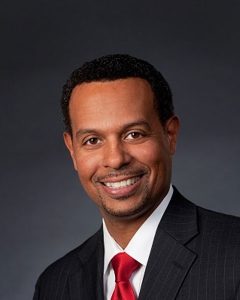 ACR CONVERGENCE 2020—In 2020, terms like unconscious bias, diversity and inclusivity are buzzwords in rheumatology, as well as throughout American society. The COVID-19 pandemic revealed stark disparities in healthcare outcomes for rheumatic disease patients of racial and ethnic minorities, including new research that shows Black and Latinx patients have a higher risk of hospitalization and threefold increased odds of requiring mechanical ventilatory support for their illness compared with whites.1
ACR CONVERGENCE 2020—In 2020, terms like unconscious bias, diversity and inclusivity are buzzwords in rheumatology, as well as throughout American society. The COVID-19 pandemic revealed stark disparities in healthcare outcomes for rheumatic disease patients of racial and ethnic minorities, including new research that shows Black and Latinx patients have a higher risk of hospitalization and threefold increased odds of requiring mechanical ventilatory support for their illness compared with whites.1
What do bias, diversity and inclusivity really mean, especially for leaders of academic medical centers who hire staff or recruit students, or healthcare providers treating patients? At ACR Convergence 2020, Marc A. Nivet, EdD, executive vice president for institutional advancement at UT Southwestern Medical Center, Dallas, shared his ideas on how organizations may build on bias training sessions to implement measurable strategies that foster a lasting culture of inclusivity.
Bias & Clinical Decision Making
Bias is a tendency or inclination that results in judgments made without question, said Dr. Nivet.
“We talk about bias, and the connotation, especially within academic medicine, is that bias is inherently negative. Biases are shortcuts that we all take and actually help us more often than not. But there are times when those shortcuts disadvantage certain groups and populations, depending on how we use our biases,” he said. “Just by becoming more conscious of our biases, we can be more thoughtful about the impact they have on our work.”
When hiring medical staff or recruiting students, people may lean on their unconscious biases and exhibit preferences for candidates who resemble them or share their training background, what Dr. Nivet called the Mini-Me syndrome.
Informed decision making may also reflect unconscious biases held by clinicians that affect outcomes for different patient populations, he said, citing two examples. In a 2016 study, half of white medical students and residents believed Black patients have biological differences, such as less sensitive nerve endings or thicker skin, that made them less likely to sense pain and require treatment.2 In a 2013 study, 57% of Canadian physicians discussed total knee arthroplasty with male patients with moderate knee osteoarthritis, while only 15% discussed the surgery with female patients with the same diagnosis, although the reason for this disparity was not explained, he said.3

Dr. Nivet
Diversity in Medical Education
How do medical schools, training programs and medical specialties take steps to limit the impact of biases and advance common goals in medicine and medical education? Racial disparity gaps are glaring in U.S. medical schools, which show flat, relatively low matriculation rates for Black males over the past 35 years, Dr. Nivet said.4 These gaps appear in professional rheumatology ranks as well: Only 0.8% of practicing adult rheumatologists are Black and 8.5% are non-white Hispanic, while 73.6% are white, according to the 2015 ACR Workforce Study of U.S. rheumatologists and rheumatology professionals.5
Professional medical associations have taken public steps to address bias in 2020. In January, the American Academy of Family Physicians (AAFP) released an implicit bias training guide for physicians and health professionals. In June, the ACR issued a position statement on its commitment to promote inclusivity and address racial disparities specific to rheumatic disease patients, such as higher mortality among Black patients with lupus, which specifically stated that racial inequality impacts the lives of ACR/ARP members and their patients.
More diversity and cultural competence in medical school programs and the physician workforce may benefit racial and ethnic minorities, women and LGBTQ patient populations, although this remains a theory, said Dr. Nivet. “This would create an environment where it’s not just individuals benefiting from the chance to go to medical school, but as healthcare providers, to bring their backgrounds and experiences to patients or to underserved communities.” Non-minority students and clinicians may benefit from exposure to different perspectives from peers who are from different racial, ethnic, socioeconomic or other backgrounds, he said.
Retention & Satisfaction
Diverse hiring and student recruitment programs, as well as implicit bias training courses, are only the first steps to more inclusivity.
“What do we want diversity to accomplish? We want to elevate our rationales and approaches to create more equitable, inclusive environments,” said Dr. Nivet. “We should not just focus on recruitment or retention, [which may mean] keeping people on staff even if they’re unhappy or not thriving in their programs.”
Next steps for institutional leaders include creating cultures that encourage individuals from diverse backgrounds to stay and achieve success benchmarks, which may need to be created by said leaders. Benchmarks may include medical students graduating, residents finding jobs or academic professionals attaining tenure. Find ways to assess, measure and track the satisfaction levels of students, educators and researchers, so you know that any investments in implicit bias training or diversity efforts are really working, he said.
What do terms like bias, diversity & inclusivity really mean?
“Focus on your institution’s culture and mindsets. Diversity can go from an adjunct concept on the periphery to a core principle of your institution when you think of excellence in optimal patient care delivery, research or education,” Dr. Nivet said. Leaders must ask deeper questions about the fruits of their diversity efforts in training and research. For example, what if residency program graduates are working only in suburban areas, not rural or other underserved areas? “What about your research agenda? Are you still primarily valuing the basic sciences, or are you giving equal weight to translational, community engagement or comparative effectiveness research? Are people thriving in promotion and tenure only in basic sciences, or is this happening in other areas?”
Diversity Is Not the Endpoint
To lay the groundwork for a more equitable healthcare environment for professionals and patients, academic leaders must develop a new mindset and mission, said Dr. Nivet. “This can be, ‘We cannot be a preeminent academic medical institution if we are not inclusive, diverse and equitable,” he said. “If I walk around campus and see there is only one African American male in our first-year medical school class, that needs to make us say something is wrong.”
At his institution, diversity of the student or professional staff ranks is not the endpoint, but a tool to be harnessed to drive and advance health equity for patients and equitable opportunities for professionals in medicine, said Dr. Nivet. Accountability helps institutions stay on track. Assess the inclusivity of your institution and the success of diversity initiatives through surveys that ask students and staff how they feel about the culture. “We need a data-driven approach if we are going to make investments in our institutions” and create lasting, meaningful change, Dr. Nivet said.
Dr. Nivet closed by paraphrasing Martin Luther King Jr.: “The ultimate solution to the equality or race problem lies in the willingness of men and women to obey the unenforceable.”
Susan Bernstein is a freelance journalist based in Atlanta.
References
- Gianfrancesco M, Leykina L, Harrison C, et al. Race/ethnicity is associated with poor health outcomes amongst rheumatic disease patients diagnosed with COVID-19 in the US: Data from the COVID-19 Global Rheumatology Alliance Physician-Reported Registry [abstract]. Arthritis Rheumatol. 2020 Oct; 72 (suppl 10).
- Hoffman KM, Trawalter S, Axt JR, et al. Racial bias in pain assessment and treatment recommendations, and false beliefs about biological differences between blacks and whites. PNAS. 2016 Apr 19;113(16):4296–4430.
- Borkhoff CM, Hawker GA, Kreder HJ, et al. Influence of patients’ gender on informed decision making regarding total knee arthroplasty. Arthritis Care Res. 2013 Aug;65(8):1281–1290.
- Laurencin C, Murray M. An American crisis: The lack of Black men in medicine. J Racial Ethn Health Disparities. 2017 Jun;4(3):317–321.
- American College of Rheumatology. (2016). 2015 Workforce Study of Rheumatology Specialists in the United States. Retrieved from https://www.rheumatology.org/portals/0/files/ACR-Workforce-Study-2015.pdf.



